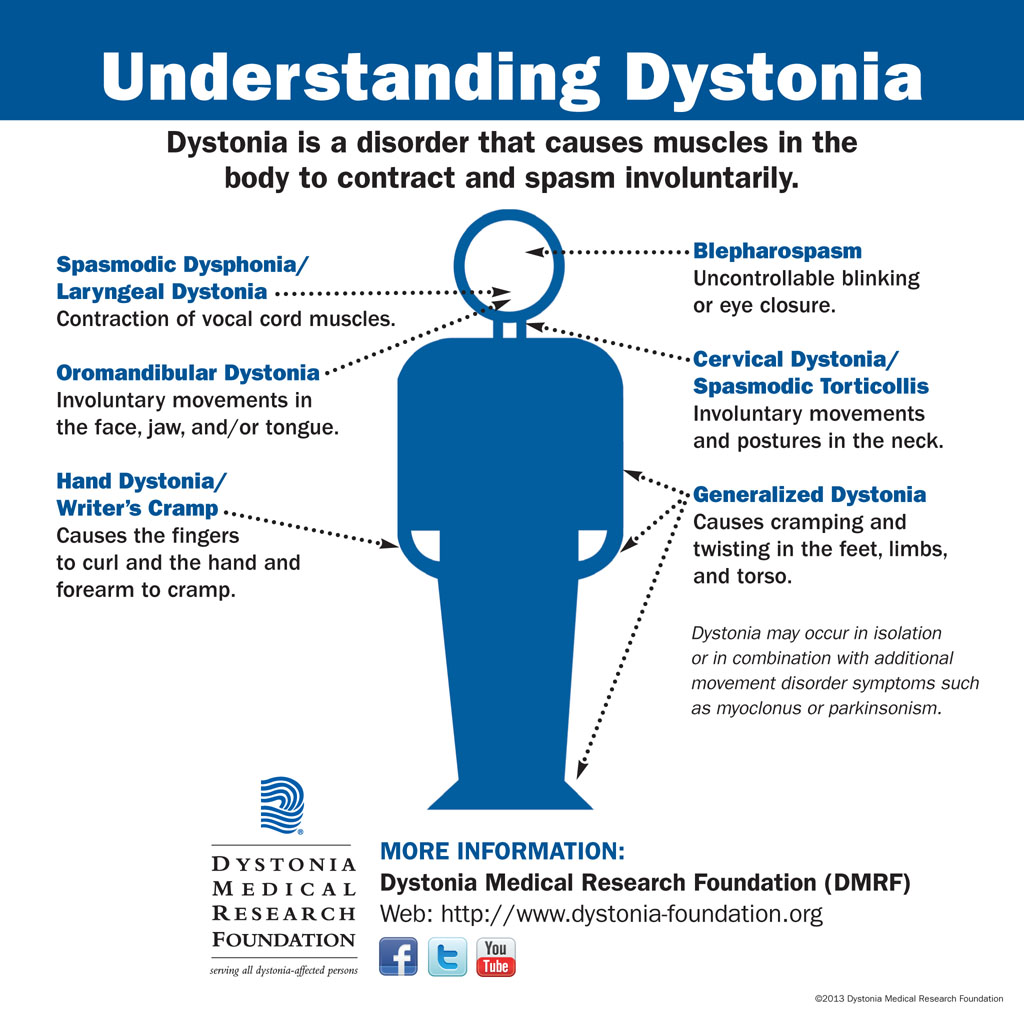Introduction
Dystonia is a medical term for a range of movement disorders that cause muscle spasms and contractions.
The spasms and contractions may either be sustained or may come and go.
Movements are often repetitive and cause unusual, awkward and sometimes painful postures. Tremor (shaking) can also be a characteristic of some types of dystonia.
Dystonia is thought to be a neurological condition (caused by underlying problems with the brain and nervous system). However, in most cases, brain functions such as intelligence, memory and language remain unaffected.
Types of dystonia
Dystonia can affect only one muscle or a group of muscles. There are five main types of dystonia:
Focal dystonia – where a single region, such as the hand or eyes, is affected. Cervical dystonia, blepharospasm (abnormal twitch of the eyelid), laryngeal dystonia and writer’s cramp are all examples of focal dystonia. If it only affects someone during specific activities, such as writing, it’s described as task-specific dystonia.
Segmental dystonia – where two or more connected regions of the body are affected. Cranial dystonia (blepharospasm affecting the lower face and jaw or tongue) is an example.
Multifocal dystonia – where two or more regions of the body that aren’t connected to each other, such as the left arm and left leg, are affected.
Generalised dystonia – where the trunk and at least two other parts of the body are affected. The legs may or may not be affected.
Hemidystonia – where one entire side of the body is affected.
About 90% of all cases are either cervical dystonia (which affects the neck muscles) or blepharospasm (which affects the eyelids). These are both focal dystonias that tend to develop later in life. They don’t usually get any worse and no other muscles are affected.
Read more about the symptoms of dystonia.
Causes of dystonia
Exactly how dystonia develops remains uncertain, but it’s thought to be caused by a problem with the part of the brain that controls muscle movement (the basal ganglia).
If there’s no identifiable cause of dystonia, or if the cause is genetic, it’s described as primary dystonia.
Secondary dystonia is where dystonia occurs as a symptom of an underlying condition or injury. Common causes include stroke, brain injury, encephalitis and Parkinson’s disease.
Read more about the causes of dystonia.
Diagnosing dystonia
Dystonia is diagnosed by a specialist examining and recognising the typical symptoms. The type of dystonia is then classified by which area of the body is affected.
When diagnosing dystonia, it’s important to confirm whether you have primary or secondary dystonia, because this may determine the type of treatment you need.
If you have typical signs of late-onset focal dystonia, specific investigations may not be required. However, tests may be needed to confirm whether you have primary or secondary dystonia. These may include brain scans, urine or blood tests, and genetic testing.
Read more about how dystonia is diagnosed.
Treating dystonia
There’s no cure for dystonia, but the condition can usually be effectively managed.
Treatment will vary, depending on the type of dystonia you have and the precise nature of your symptoms. However, the four main types of treatment are:
botulinum toxin – widely used to treat neurological conditions that involve abnormal muscle contractions, such as dystonia; it’s injected into the affected muscles to temporarily weaken them and reduce spasms
medication – such as anticholinergics, Baclofen and muscle relaxants
physiotherapy – where exercises are used to improve range of motion and posture, and prevent muscle weakness
surgery – if other treatments are unsuccessful, the nerves controlling the muscles causing spasms can be cut (selective peripheral denervation), or electrodes can be implanted within the brain, which are connected to a small device that’s similar to a pacemaker (deep brain stimulation)
Read more about how dystonia is treated.
Outlook
Dystonia is an unpredictable condition. It tends to progress slowly and the severity of a person’s symptoms can vary from one day to another.
Focal dystonia usually progresses gradually over a period of about five years and then doesn’t get any worse.
Sometimes, a person’s symptoms improve or disappear completely. This is known as total remission and it’s thought to occur in around 5-10% of people.
